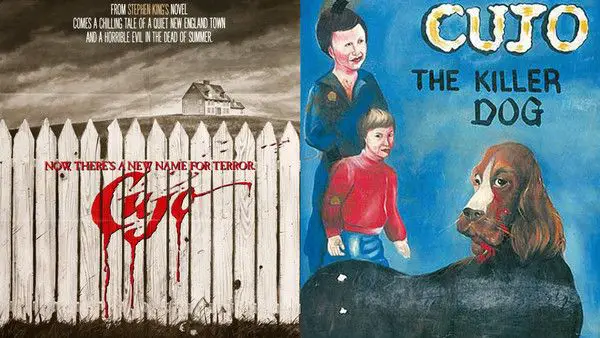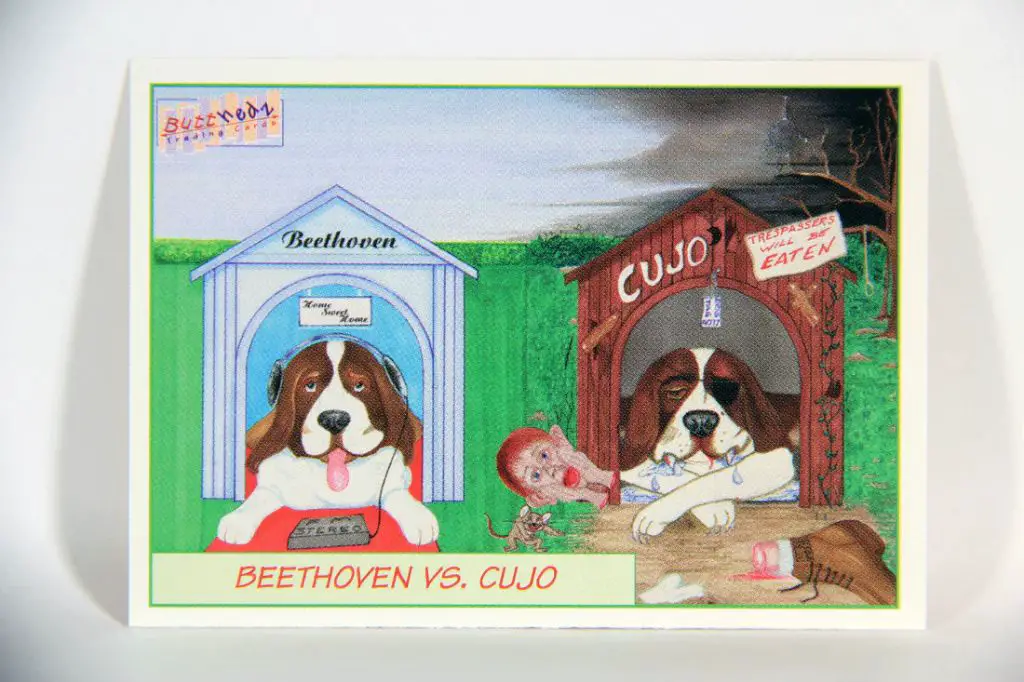Introducing Cujo and Beethoven
Cujo and Beethoven are two iconic canine movie characters that have captured the hearts of audiences. Cujo first appeared in Stephen King’s 1981 novel of the same name before being adapted into a film in 1983. The St. Bernard dog was played by several canine actors, although the main role was handled by a dog named Mushroom. In the story, Cujo contracts rabies and turns aggressive, trapping a mother and her young son in a car. Beethoven, on the other hand, is the lovable St. Bernard from the 1992 family comedy film Beethoven. The dog was played primarily by a canine actor named Chris, trained by animal handler Karl Miller. Unlike the murderous Cujo, Beethoven is a friendly and heroic dog who becomes part of a human family. Both Cujo and Beethoven left lasting impressions through their big screen roles, despite being quite different in temperament.
Comparing Physical Attributes
Cujo and Beethoven were both St. Bernard dogs, which is a very large working breed originating from the Swiss Alps. According to the American Kennel Club, the average St. Bernard stands between 25.5 and 27.5 inches tall at the shoulder and weighs between 120-200 pounds. They have a short, thick, and flat coat that can be redish-brown and white or brindle in color.
In the movie Cujo, several St. Bernard dogs were used to portray the rabid Cujo. According to NYFA, the main dog who played Cujo was a St. Bernard named Bang. Similarly, in the Beethoven movies, the title role was played primarily by a St. Bernard named Chris. Both Cujo and Beethoven were large, fluffy St. Bernard dogs with the typical markings and physical features of the breed.
However, there were some differences between the on-screen dogs. Beethoven was portrayed as an oversized St. Bernard, weighing over 200 pounds. Cujo was an average-sized St. Bernard. Beethoven had longer fur that was styled and groomed for his comedic family-friendly role. Cujo had a more natural rugged, unkempt look befitting his role as a rabid dog.
Origins and Backstories
Beethoven was a large St. Bernard owned by the Newton family in the popular 1992 film Beethoven. According to the NYFA article, Beethoven was played by a dog named Chris who came from a breeder called Le Pets. The dog was trained by renowned animal trainer Karl Miller. In the film, Beethoven starts out as a cute puppy adopted by the Newton family before growing into a large, lovable, and mischievous dog. He ends up causing comedic chaos around the home but ultimately bonds with the family.

In contrast, Cujo was portrayed as a rabid St. Bernard in the 1983 Stephen King novel and movie Cujo. According to the article from the LA Times, Cujo was actually played by several trained dogs in the movie adaptation. The original novel did not specify the dog’s breed. Cujo contracted rabies after getting bitten by a bat and became violently aggressive, attacking the mother (Donna) and son (Tad) who were trapped in their car. Unlike the gentle Beethoven, Cujo was transformed into a dangerous killer dog by the rabies virus.
Movie Plot Summary
The 1983 horror film Cujo is based on Stephen King’s 1981 novel of the same name. It follows Donna Trenton (Dee Wallace) and her young son Tad (Danny Pintauro) as they are trapped in their Ford Pinto while trying to escape a rabid St. Bernard named Cujo (Wikipedia). Cujo contracts rabies after being bitten by a bat and embarks on a killing spree in the small town of Castle Rock, Maine. Donna and Tad become trapped in their car for several days as Cujo relentlessly tries to attack them. The situation becomes increasingly dire as they suffer from dehydration and heatstroke in the hot sun. In the end, Donna uses the last of her strength to kill Cujo with a baseball bat.
In contrast, the family comedy Beethoven (1992) features the title character, a St. Bernard, as a friendly pet who bonds with the Newton family. After Beethoven accidentally wrecks the home and becomes a chaos-causing handful, George Newton wants to get rid of him. But the family members have all grown fond of Beethoven and conspire to keep him without George finding out. Beethoven gets dog-napped by an abusive animal trainer but is ultimately rescued and reunited with the Newtons (IMDb). While Cujo is a horror film centered around a rabid dog, Beethoven is a lighthearted comedy focused on the antics of a lovable St. Bernard.
On-Screen Personas and Behaviors
Beethoven and Cujo portrayed very different on-screen personas and behaviors in their respective films.
In the Beethoven movies, Beethoven was depicted as a lovable and mischievous St. Bernard dog. He was friendly, energetic, and constantly getting into trouble around the house, knocking things over with his large size and drooling everywhere. However, he was also loyal and protective of the family he lived with. The movies emphasize his sweet temperament and desire to play and be part of the family.

In contrast, in the movie Cujo based on Stephen King’s novel, Cujo was a friendly St. Bernard who unfortunately contracted rabies after being bitten by a bat. The rabies transformed Cujo’s personality, turning him aggressive and violent. In the film, Cujo attacks and kills several people while trying to kill a mother and her young son trapped in a car. He is depicted as a horrifying monster out for blood, completely taken over by the madness caused by the rabies infection.
So while both dogs are St. Bernards, their on-screen personas are completely opposite. Beethoven is harmless and lovable, while Cujo is terrifying and vicious. This underscores how the filmmakers were able to use the same dog breed to tell two very different cinematic stories.
Impact on Pop Culture
Stephen King’s 1981 novel Cujo and its 1983 film adaptation had a significant impact on popular culture, particularly in shaping public perception of the Saint Bernard breed. The story centers around a rabid Saint Bernard named Cujo that terrorizes a mother and her young son trapped in their car. Cujo is portrayed as a horrifying and vicious killer, in stark contrast to the real-life gentle and friendly nature of Saint Bernards.
After the popularity of Cujo, the Saint Bernard breed began to develop an unfair reputation as dangerous. According to one article, people started crossing the street to avoid Saint Bernards, and adoption rates for the breed dropped dramatically. The name “Cujo” became synonymous with crazed, murderous dogs. This stigma persisted for many years after the book and movie’s release.
While Cujo is a fictional character, the story reinforced unfounded stereotypes about Saint Bernards being prone to aggression and attacking people. However, in reality Saint Bernards are gentle giants known for being great family dogs. The American Kennel Club describes them as “friendly, gentle, and eager to please.” Cujo‘s sensationalized depiction continues to negatively impact perceptions of the breed today.
Behind the Scenes
Cujo utilized several trained dog actors to portray the rabid St. Bernard. According to Screen Rant, there were five St. Bernard dogs used in the film – one mechanical dog, and four real dogs named Mushroom, Buddy, Teddy, and Billy. The dogs went through extensive training for the film under veteran animal trainer Karl Miller, who also trained the dogs in the Beethoven movies.
Training the dogs for Cujo was challenging, as the dogs had to act aggressive, while ensuring no harm came to the human actors. Clever camera angles and editing were used to make the dogs appear menacing. For the most dangerous scenes, stuntman Gary Morgan wore a large dog costume. The production required keeping the dogs cool and calm between takes, and providing positive reinforcement for good behavior.
In the end, the teamwork between the professional animal trainers, talented dog actors, and film crew resulted in creating the iconic Cujo while keeping everyone safe on set. As one of the trainers remarked, “the dogs were superstars” during the demanding production.
Sources:
https://screenrant.com/cujo-every-animal-human-used-in-the-stephen-king-movie-explained/
https://en.wikipedia.org/wiki/Cujo_(film)
Critical Reception

Cujo received mixed reviews upon its release. While some praised the tense atmosphere and Dee Wallace’s performance, others felt the film relied too much on horror cliches.
In their review, Roger Ebert gave the film 2.5 out of 4 stars, writing “Cujo starts well…and then it starts to fall apart into a series of horror clichés.” Reviews on IMDB were more positive, with Cujo holding a 6.6/10 average rating from over 20,000 users.
Despite the mixed critical reception, Cujo performed well at the box office. On a budget of $5 million, it went on to gross over $21 million, showing the drawing power of the horror genre and Stephen King’s popular novel.
Audiences responded well to the tense atmosphere and Dee Wallace’s emotional performance. Many felt it captured the horror of the book, praising the sense of isolation and claustrophobia during the climactic car scenes. However, some found the gore gratuitous and felt the film lacked substance. Overall, Cujo proved a commercial success despite polarizing critics.
Lasting Legacies
Although Cujo and Beethoven were different dogs who played very different roles, they both left a lasting legacy in pop culture. Beethoven sparked several sequels and became synonymous with the lovable St. Bernard dog breed. According to The Real Dogs Behind 10 Iconic Canine Roles, Beethoven enjoyed “one heck of a legacy” as one of only three real-life animals to have a star on the Hollywood Walk of Fame.
Meanwhile, Cujo left his mark as one of the most famous horror film antagonists. The Saint Bernard turned rabid killer cemented Stephen King’s reputation as a master of horror and thrills. Even though Cujo was a trained movie dog, his name became synonymous with the dangers of rabies and the fear of “man’s best friend” turning against humans. Both Cujo and Beethoven left indelible marks on pop culture through their unforgettable on-screen performances.
The Verdict
While Cujo and Beethoven are both iconic Saint Bernard dogs in cinema, they were actually played by different dogs. Cujo was portrayed by several trained Saint Bernard dogs, with the main one being a dog named TD (src). In contrast, Beethoven was played primarily by a Saint Bernard named Chris throughout the Beethoven franchise (src).
There’s a common misconception that Cujo and Beethoven were played by the same dog. While they are bothSaint Bernards, and have some physical similarities, they are completely different dogs. Cujo was trained specifically for the horror film, to portray aggressive behaviors on command. Beethoven was trained more for family-friendly comedic roles across multiple films.
In summary, while Cujo and Beethoven share similarities as iconic Saint Bernard dogs in cinema, they were portrayed by different trained dogs. Cujo was primarily played by a dog named TD, while Beethoven was portrayed by a dog named Chris.
